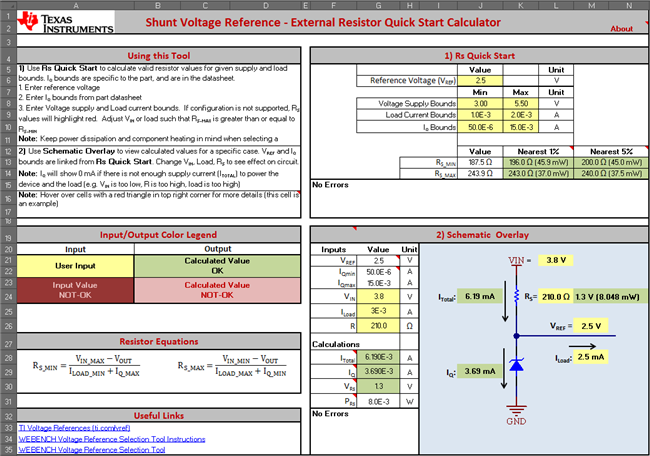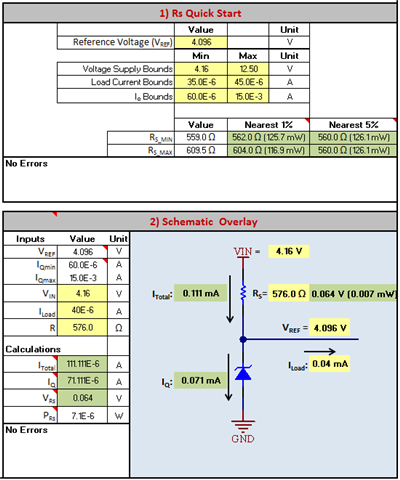SSZTBK8 february 2016 ADS8320 , LM4040 , LM4040-N
Sometimes, choosing one voltage reference topology over another can be similar to deciding whether you want a cup of coffee or plain water in the morning. Sure, the water might feel fresh and cleansing, but the caffeine in that coffee is really necessary.
In the same way, series references often offer low dropout, but shunt references can handle any input voltage. The external resistor that goes with the shunt reference combines advantages from both. When chosen carefully, the external resistor will allow you to have a voltage reference that can support a wide-input voltage range and operate with low dropout.
To ensure that the shunt current stays within the operating current range of the device, you must choose an external resistor within the bounds defined in Equations 1 and 2:

TI’s new External Resistor Quick Start Calculator tool simplifies resistor selection by providing instant numerical and visual feedback on the effects the inputs have on the outputs. See Figure 1.
 Figure 1 External Resistor Quick Start
Calculator Interface for Shunt References
Figure 1 External Resistor Quick Start
Calculator Interface for Shunt ReferencesStarting in the resistor (RS) Quick Start quadrant, input the values for output reference voltage (VREF), input supply-voltage range, load current range and operating current range. In the Schematic Overlay quadrant, input the input voltage, load current and resistor value involved with VREF. The tool will immediately illustrate whether the calculated values are viable or not. If the values will not work, they will appear in red and a guided error message will help you adjust inputs accordingly.
Let’s revisit the example in my colleague Christopher Dean’s post, which analyzed the effect of the external resistor value on the dropout voltage (VDO) of the LM4040-N. Using the LM4040-N 4.1V voltage reference with the ADS8320 Analog-to-Digital Converter (ADC), their respective data sheets have these specifications:
- LM4040-N output voltage (VOUT): 4.096V.
- LM4040-N quiescent current (IQ): 60µA to 15mA.
- The ADS8320 drains 40µA from the external reference load current (ILOAD).
Varying IQ to get the minimum and maximum input voltage (VIN) values, you can use the minimum input voltage (VIN_MIN) to calculate the minimal VDO. Table 1 illustrates how decreasing the RS value can yield a lower VDO, and Figure 2 and Figure 3 reflect these cases within the quick-start calculator tool.

|
 Figure 2 Simulation with RS
= 576Ω Yields vDO = 54mV
Figure 2 Simulation with RS
= 576Ω Yields vDO = 54mV Figure 3 Simulation with RS
= 100Ω Yields vDO = 10mV
Figure 3 Simulation with RS
= 100Ω Yields vDO = 10mVAs I’ve demonstrated, the quick-start calculator tool can be useful when designing with shunt-topology voltage references. The real-time visual feedback provides full calculations in the schematic overlay and prevents you from choosing unfeasible resistor values.
Download the Microsoft Excel-based tool and try it out.
Additional Resources
- Read the Understanding Voltage References blog series.
- See the Embedded Computing Design article, “Shunt versus series: How to select a voltage-reference topology.”
- Visit the voltage reference landing page.
- Download the “Voltage Reference Selection Basics” white paper.